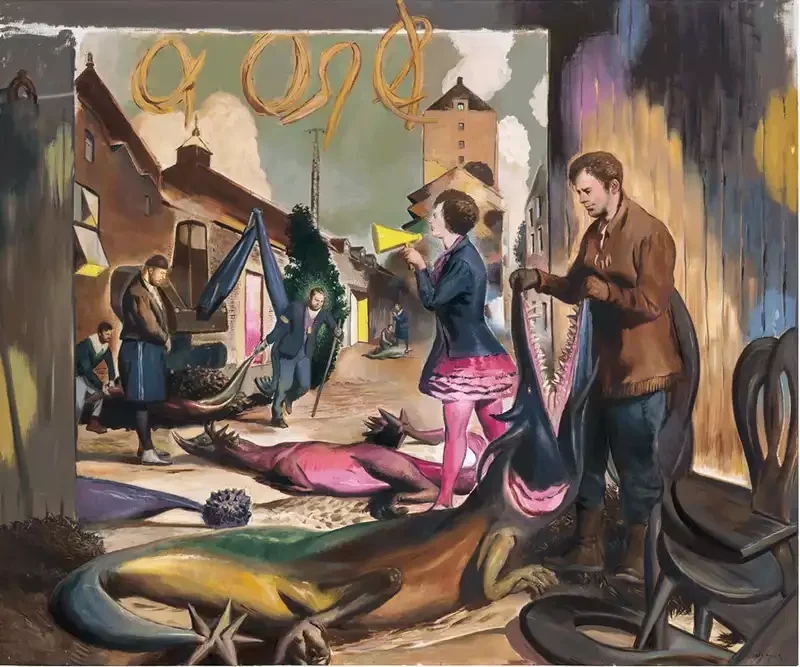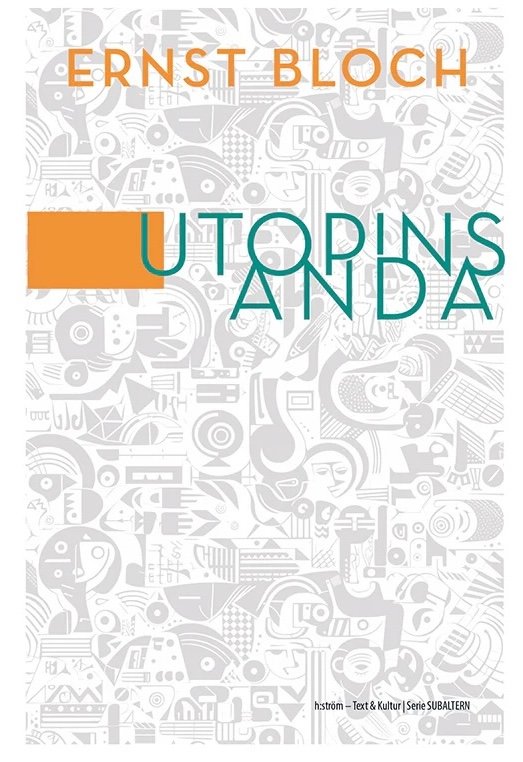On Literature as Oscillation, and Oscillation as Utopian
/This text was presented at the conference Looking Forward in Hope and Despair. Critical Perspectives on Utopia and Dystopia in Philosophy and the Arts, organized by the Center for Ethics as Studies in Human Value, University of Pardubice, Czech Republic, 14th – 16th April 2021.
A crucial aspect of this paper is its openly strategic ambitions. It aims to explicate a thinking on utopia that I take to be useful to the Left – in its broadest sense – namely the concept of a limited utopia, which, together with an oscillating approach, could be a conceptual tool for organizing a way out of capitalism. I argue that the left needs to embrace a ’non-utopia’, but one that won’t allow itself to be mixed up with the non-revolutionary, social-democratic project. Instead of aiming at Eden, we have to sensitize ourselves for where our canyons and pathways actually can lead. The aim, however, is not to bluntly oppose the current use of utopia, but to seek to complement it. Double the effort, as it were.
The text consists of four parts with slightly different angles: 1) Utopia as place and the concept of sculptural time, 2) Limitation, progress and the possible, 3) Oscillation and literature and 4) Strategy and historical situation. The first part lays down a conceptually necessary foundation for the following middle parts, where I present the two concepts limitation and oscillation, and in the last part I expound the text’s strategic situation.
1. Utopia as place and the concept of sculptural time
So – I want to propose a reversal to an earlier understanding of utopia. When Thomas More writes his Utopia in 1515 or when Samuel Butler, a couple of hundred years later, describes his Erewhon, the utopian idea is decidedly spatial. These were colonial fantasies about faraway countries, contrasting very clearly with the current uses of utopia, which, in a narrow sense of the word, are temporal. Today, we talk about utopia as buried in future landscapes, cut off from our current, daily toil. (In a conversation on utopia, Ernst Bloch and Theodor W. Adorno notes this development, and in his text An American Utopia, Fredric Jameson seems to confirm this shift to temporality, if only in passing.)
Why a reversal? Surely not to reinstate a colonial fantasy, so what is the point? Well, it has to do with counterfactuals. The general usage of utopian to describe something impractical and impossible, and as a consequence describe the status quo as inevitable or as (θέσει turned) φύσeι, has been rightly criticized by both Adorno and Jameson, to mention just two. This is in no way an unimportant criticism, but it is not unproblematic.
One reason for Adorno’s and Jameson’s insistence on the need for utopian thought is, as I understand it, the perceived decline of a sense of history, and since they equate history with an understanding of the present as changeable, decline is bad news. However, in setting this diagnosis they betray their allegiance to a narrow and modern sense of history and progress – and I think that this modern concept of history needs to at least be complemented by another understanding of time and of development. To understand utopia as ’further down’ the pathway that we are or could be walking is philosophically dubious but also, I believe, strategically fruitless.
Thus, we aim for a reversal in order not to cement a narrow understanding of history and time under the guise of utopia and possibility. This would, of course, also decouple the recent binding together of dystopia and utopia, since the emphasis is no longer on the evaluation of the character of the place – not: ’is it good or bad?’ – but on the distinction of the factual and the counterfactual, the current in the face of the non-current.
So – what type of space or spatiality would I like us to reverse to? Well, there is no sense in upholding a categorical, philosophical distinction between the phenomena space and time. For sure, there have been substantial attempts at presenting a concept of time that does not limit itself to the linear, chronometric time of modern history and modern natural or special sciences. These attempts, however, tend to hypostasize the non-moving or eternal aspects of time or, indeed, abstract the phenomenon of time from experience. They tend to take a naive approach to space, to contrast space and time. But I suggest these two things collapse, or that they, for us, have always already collapsed.
I propose an understanding of time as a sculptural phenomenon. This seems to me a useful way of creating the opportunity to envision something that does not adhere to linear, measured – I’d say capitalist, logocentric – thought. I take this idea from Marcel Proust, or more specifically, the first pages of Samuel Beckett’s essay on Proust. “Proust’s creatures,” Beckett writes,
are victims of this predominating condition and circumstance – Time […] There is no escape from the hours and the days. Neither from to-morrow nor from yesterday. There is no escape from yesterday because yesterday has deformed us, or been deformed by us. The mood is of no importance. Deformation has taken place.
This last sentence is crucial. On the one hand, it stresses the inevitability of time, its tactile and effectual nature, on the other, its sculptural character. Time, as it were, takes place or, more aptly, things and phenomena take place, and this taking of place, these depressions or cavities made in the mould of beings, this simply is time. But what bearing does this conception of time as a sculptural phenomenon have on utopia?
Firstly, sculptural time opens up the discussion on utopia towards memory studies and alternative ways of understanding the relationship between memory and history (Walter Benjamin’s “hidden index” would be a precursor). Instead of placing history and memory as opposite concepts, one can perhaps discover fruitful conceptual mixes between them or even radically new ways of understanding historical change and situatedness.
Secondly, and perhaps most importantly for this text, it wrests utopia from its connection to the perfect and the Edenic ’homecoming’ – very much a linear thing. This leads me to the second part of this text.
2. Limitation, progress and the possible
I ground a lot of what I want to address in this section on the work of Anahid Nersessian and the conceptual history of progress undertaken by Reinhart Koselleck. I have four main points: limited utopia, the possible vs possibility, growth, and diverging utopias.
First, I propose, in line with Nersessian, that the idea of utopia as linked to perfection – something explicitly stated by Adorno and Bloch, but implicit in most utopias (Jameson being a late exception) – is unviable. Why so?
One way to understand this is through the question of whether or not there is any hunger in utopia. Nersessian’s answer is, no. “Hunger in utopia,” she concludes, ”must be instantly gratified so that it no longer registers as hunger, but merely as a kind of pleasant, temporary dream-state from which one always, assuredly wakes.” A cornucopia that runs out is, reasonably, not a very good cornucopia.
On the one hand, Nersessian objects to the perfection of utopia on blunt, practical grounds: our planetary boundaries seem not to allow for a satiety of unlimited human life. On the other hand, there is a philosophically broader argument about time, namely the fact that loss, lack, bereavement, self-denial and even failure seem to be constitutively bound up with the phenomenon of time. If time is the taking of place, holes ought to be traces of time. We are, as it were, bounded by time, littered with holes. (Here, of course, Adorno would accuse me of hypostasizing the false, and there is some merit to his wish that we keep a ’radical possibility’ – he contends: death and the overcoming of death, is crucial to utopian thought – but this seems to me a clearly transhistoric position and, at least, worthy of some negation from the perspective of us living these falsehoods.)
But Nersessian goes further than to simply state that this will be the case, that sorrow and trauma will inevitably seep into utopia. She also says that she wants to ”peel away from perfection, and from perfection’s etymological commitment to ambition fully implemented”, i.e. she urges us to voluntarily choose limiting ourselves. We might be bound to always be deformed and to always deform what we meet, but there are modes, timbre, flavor. In other words, intensity is a volitional aspect of the inevitable deformation.
In sharp contrast to what we could call the utopia of Eden, Nersessian proposes a limited utopia characterized by a “low adjustment”. She thus advances a view on utopia that is constituted by absolving, by handing over and by restraint, rather than possession or insatiability. (This should however not be connected to the argument about perfectibility, i.e. a turning away from the perfect cannot rely on lack as simply that which can be amended.)
What I take Nersessian to suggest, thus, is a utopia that constantly upholds the space between the factual and the counterfactual, or between the current and the better, a space in which we have to live or that has to be lived. A constant ’almost’ that is not just a progression, but also a desired absolving and failure (and, of course, success).
The second point in this second part of the text deals, at least partly, with Adorno’s use of utopia as a way of not hypostasizing the status quo.
The problem for Adorno is that the current and existing cannot be taken to be unchangeable and eternal. Utopian thought promises that things can and indeed must be better and that what is now, is not all. Here Adorno relies both on Karl Marx and, not surprisingly, on G. W. F. Hegel. “What is, is not what it is” – this pithy formulation of Adorno points both to the Schein-character of existing society and the developmental, concrete reality of things. The bud, as Hegel puts it in the preface to the Phenomenology of Spirit, does not stand in contradiction to the flower and, I’d argue, the seed is no contradiction of the tree.
So far so good. But where I think Adorno errs is in his juxtaposition (not always apparent) of the non-identical and the utopian. To be sure, this is a complex relationship, but it seems to me that the formal possibility (of change) that Adorno clings to in using utopia or emphasizing utopian discourse, is exactly the type of hypostasizing or reification of the universal that he denounces in Hegel’s mixing of the particular [Besonderes] and particularity [Besonderheit]. The possibility that Adorno (and, to a lesser extent, the anti-anti-utopianism of Jameson) clings to, is exactly not the possible, but possibility. It is a hypostasized counterfactual, that instead of looking at the actual teleologies or possibilities – the cavities of the sculpture, of which Adorno does talk, albeit briefly and rather with Plato than with Proust in mind – grasps the monolithic Possible. It should also be noted, that these possibilities are not the same as the common-sensical “practical”, but they are, rather, simply the objective or concrete aspect of the current, the development of these things, our development.
This differentiation between possibility and the possible and the comparison with Hegel leads me to my third point, namely that of growth. As I already pointed out the anti-progress argument, both Nersessian’s and mine, is based loosely on Koselleck’s explication of the concept of progress. To be clear: I don’t want to bicker about the possible impracticalities of endless growth, but rather refute a certain type of growth, which, endless or not, sees an actual end, aims for an end ’further down the road’. Why is this problematic? My argument is simple: Certain developments do not allow for skipping steps and we can’t see all intermingling movements. The Hegel of the Phenomenology of course talks in terms of ends and teleology, but what is more important for this text is his emphasis on the working through of things; the revolution has happened, it is born, but it is not finished, the seed sprouts but it is not yet the plant it will be, et cetera.
Now, obviously the psyche or the spirit or thought – I’ll have to be vague here – is not a plant; not all developments are as step-bound or gradual as that of a growing, material organism. But there is, I think, some merit to arguing that the human psyche – however free its phantasmatic or imaginary powers are – does show a sluggishness that can be equated with a material boundedness. One thinks of Sigmund Freud’s concept of durcharbeiten, which underlines the fact that the analysis is in no means finished when the analyst has succeeded in pointing out the resistances or the problems that the analysand has refused to acknowledge. Showing resistance is not the same as breaking it down or letting it go.
Resistance is of course a concept that is closely connected to Adorno, but it seems he does not acknowledged this type of resistance, this tardiness, at least not in his discussions on utopia.
What I’m aiming at here, my fourth point, is the overarching risk that there will be mutually incongruent utopian developments or goals. “What is, is not what it is” – yes. But what is not, is not one, but multiple, albeit limited possible developments. Everything is possible, but not necessarily at the same time, not necessarily now, not simultaneously. This is not a consequence of positing a positive conception of utopia, but rather inherent in the very fact of non-identity, of particular and different developments – different indentations in the sculpture – and, importantly, the possibility that one can always ’depart’ from utopia, i.e. the problem of falsity and, consequently, of wounds. The memory of a wound is not simply solved by entering into a non-wounded state – the being raised in the false is, as Adorno does acknowledge, perhaps not fit for the true. Thus, the development will not allow us skipping ahead.
3. Oscillation and literature
This leads me to my third part, which concerns the ever so actual question: What to do, then? I propose that oscillation could function as a practical, political trope to understand how to judge one’s own moment in a utopian development and, indeed, how to live such a realization. Oscillation, one could say, as akin to the therapeutic situation. Here, I have three points. First off, I will briefly explicate the concept of idiorrhythmy as used by Roland Barthes, then I will describe in what way this is connected with literature, and lastly I quarrel, again, a bit with Adorno and his promesse de bonheur.
It is in his seminar titled How to Live Together that Barthes develops a utopian discourse that hinges on the concept of idiorrhythmy, a term he borrows from Jacques Lacarrière, but which he infuses with his own theoretical content. He takes as his exemplary starting point the communities of early monks and anachorites, who would offer bothcommunal and personal spaces, creating an oscillation between the rules, schedules and strictures of the monastery and the idiosyncratic or personal desires of the individuals. What I take the core of Barthes’ project to be, is the supple and rhythmical (in contradistinction to metrical) cohabitation of the individual and the collective, but also, extrapolated, between different lifeforms or developments. The prefix of the term is crucial, since that is what, for Barthes, stops the rhythm turning rigid and regulative. The simplest way of understanding this, is to see this idios- as a way of stopping rhythm turning into meter. Idiorrhythmy is relational, not durational, variable, not fixed, and it points to and allows what evades or cannot be made to fit the meter. This reflects what I perceive to be a larger oscillating movement visible in some of Barthes’ works, perhaps aptly formulated in his pondering in Mythologies on the relationship between France and wine, where he states that “wine is objectively good, and at the same time, the goodness of wine is a myth” – a colonial myth – and this causes us to “constantly drift between the object and its demystification”.
I argue, partially building on Nersessian’s idea of the genre “secular realism”, that literature might be construed as an objective expression of idiorrhythmy and oscillation. Secular realism, briefly summarized, is a phenomenological sensitivity, a way of describing the existing in a way that shows its immanent connection to the non-existing, or, by quoting Nersessian quoting Barthes: “Realism […] is genuinely weird”.
Without making all too sweeping claims, I would say that this applies to texts in general – if not all, then at least quite a few – and not only to those emphasized by Nersessian (which are limited to Anglo-Irish Romanticism).
For example, I take the Swedish literary critic Mikaela Blomqvist’s essay “Literature and reality in postmodernity. On Peter Handke” to depict this generality. She writes that,
what Handke’s later writings show, is that this minimal surface [between a train track, a runway and a motorway] can be expanded into what appears to be eternity. How much does a human contain? The world is tirelessly nuanced, and contemporary with me, is all I can picture.
(To be clear: These are just two literary examples – the same structure could be seen in Celan (the idea of poetry fulfilling itself is decidedly sculptural) or in another sense in the documentary prose of Clarice Lispector, or the late writings of Friederike Mayröcker, just to mention a few.)
Fundamentally, it is about stitching together the temporally possible with the spatially existing – a rather blunt turn of phrase perhaps – which, to once again quote Nersessian ”allows futurity itself to remain anchored by the pressures of a materially restrictive present.” The space created by the overlay of language on the real, the slit between signifier and what is signified, this gap which we know so much about, this is the space where we live but also where there is any chance at all of change. Oscillating between language and the phenomena, one comes to see both the possible and the existing. This turns utopia on its head, in a sense: future becomes place-bound, the non-place becomes place.
Now, the idea of art somehow showing what could be possible through a performative non-coherence of course comes very close to Adorno’s promesse de bonheur, in which the artwork incapsulates the antagonizing incoherence of society. As the historian S. D. Chrostowska puts it, when summarizing Adorno’s promesse, art
keeps the promise of happiness not by making good on it but by withholding immediate happiness: by denying immediate wish fulfillment, redeeming happiness in a round-about, dialectical fashion […] – pleasure wanting eternity, as Adorno notes, following Nietzsche.
But what differentiates my proposed oscillation from this, is that it isn’t a promise. It does not aim for perfection, it insists on pleasure not necessarily wanting eternity, but rather, that there is at least some sort of pleasure that can grow in this small, disappointing and joyous, obvious but unstable hither and thither – dither – that human life currently is.
4. Strategy and historical situation
As it happens, it looks like I’ve run out of time and that I will not be able to really explicate my fourth theme, that of strategy. A failure on my part, perhaps. But luckily, I mentioned it in the beginning, it was already there, and perhaps its meaning or importance wasn’t entirely visible until we turned the sculpture around anyway.
I want to end, though, with repeating that I do not wish to supplant utopian thought, but merely complement it. There is some merit to utopia. But simply revealing truth does not do away with the false and, at the very least, there needs to be a serious working through of what is revealed – a lot of kneading, moulding, growing. From this perspective the non-utopian view I’ve outlined above seems like a fruitful addition. One could, perhaps, call all of this a sort of dual power.
Erik Lindman Mata
Spring 2021

































